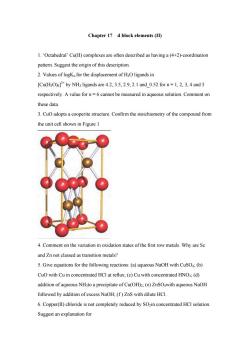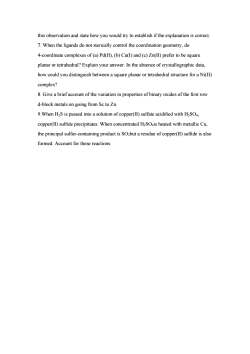北京化工大学:《无机化学》课程电子教案(试卷习题)第十七章自我练习题及答案

Chapter 17 d block elements(II) 1.Octahedral'Cu(ll)complexes are often described as having a(4+2)-coordination pattern.Suggest the origin of this description. 2.Values of logK for the displacement of H2O ligands in [Cu(H2O)by NH;ligands are 4.2.3.5,2.9.2.1 and_0.52 for n=1.2.3,4 and 5 respectively.A value forn=6cannot be measured in aqueous solution.Comment or these data. 3.Cu adopts a cooperite structure.Confirm the stoichiometry of the compound from the unit cell shown in Figure 1 4.Comment on the variation in oxidation states of the first row metals.Why are Sc and Zn not classed as transition metals? 5.Give equations for the following reactions:(a)aqueous NaOH with CuSO (b) CuO with Cu in concentrated HCI at reflux;(c)Cu with concentrated HNO3;(d) addition of aqueous NH3to a precipitate of Cu(OH)2;(e)ZnSO,with aqueous NaOH followed by addition of excess NaOH;(f)ZnS with dilute HCI. 6.Copper(II)chloride is not completely reduced by SOzin concentrated HCI solution Suggest an explanation for
Chapter 17 d block elements (II) 1. ‘Octahedral’ Cu(II) complexes are often described as having a (4+2)-coordination pattern. Suggest the origin of this description. 2. Values of logKn for the displacement of H2O ligands in [Cu(H2O)6] 2+ by NH3 ligands are 4.2, 3.5, 2.9, 2.1 and_0.52 for n = 1, 2, 3, 4 and 5 respectively. A value for n = 6 cannot be measured in aqueous solution. Comment on these data. 3. CuO adopts a cooperite structure. Confirm the stoichiometry of the compound from the unit cell shown in Figure 1 4. Comment on the variation in oxidation states of the first row metals. Why are Sc and Zn not classed as transition metals? 5. Give equations for the following reactions: (a) aqueous NaOH with CuSO4; (b) CuO with Cu in concentrated HCl at reflux; (c) Cu with concentrated HNO3; (d) addition of aqueous NH3to a precipitate of Cu(OH)2; (e) ZnSO4with aqueous NaOH followed by addition of excess NaOH; (f ) ZnS with dilute HCl. 6. Copper(II) chloride is not completely reduced by SO2in concentrated HCl solution. Suggest an explanation for

this observation and state how you would try to establish if the explanation is correct. 7.When the ligands do not sterically control the coordination geometry,do 4-coordinate complexes of(a)Pd(II),(b)Cu(I)and(c)Zn(II)prefer to be square planar or tetrahedral?Explain your answer.In the absence of crystallographic data how could you distinguish between a square planar or tetrahedral structure for a Ni(II) complex? 8.Give a brief account of the variation in properties of binary oxides of the first row d-block metals on going from Sc to Zn 9.When HS is passed into a solution of copper(I)sulfate acidified with H2SO copper(Isulfide precipitates.When concentrated HSOis heated with metallic Cu. the principal sulfur-containing product is SObut a residue of copper(I)sulfide is als formed.Account for these reactions
this observation and state how you would try to establish if the explanation is correct. 7. When the ligands do not sterically control the coordination geometry, do 4-coordinate complexes of (a) Pd(II), (b) Cu(I) and (c) Zn(II) prefer to be square planar or tetrahedral? Explain your answer. In the absence of crystallographic data, how could you distinguish between a square planar or tetrahedral structure for a Ni(II) complex? 8. Give a brief account of the variation in properties of binary oxides of the first row d-block metals on going from Sc to Zn. 9.When H2S is passed into a solution of copper(II) sulfate acidified with H2SO4, copper(II) sulfide precipitates. When concentrated H2SO4is heated with metallic Cu, the principal sulfur-containing product is SO2but a residue of copper(II) sulfide is also formed. Account for these reactions
按次数下载不扣除下载券;
注册用户24小时内重复下载只扣除一次;
顺序:VIP每日次数-->可用次数-->下载券;
- 北京化工大学:《无机化学》课程电子教案(试卷习题)第十五章自我练习题及答案.pdf
- 北京化工大学:《无机化学》课程电子教案(试卷习题)第十三-十四章综合自我练习题及答案.pdf
- 北京化工大学:《无机化学》课程电子教案(试卷习题)第十四章自我练习题及答案.pdf
- 北京化工大学:《无机化学》课程电子教案(试卷习题)第十二章自我练习题及答案.pdf
- 北京化工大学:《无机化学》课程电子教案(试卷习题)第十三章自我练习题及答案.pdf
- 北京化工大学:《无机化学》课程电子教案(试卷习题)第十章自我练习题及答案.pdf
- 北京化工大学:《无机化学》课程电子教案(试卷习题)第十一章自我练习题及答案.pdf
- 北京化工大学:《无机化学》课程电子教案(试卷习题)第八章自我练习题及答案.pdf
- 北京化工大学:《无机化学》课程电子教案(试卷习题)第九章自我练习题及答案.pdf
- 北京化工大学:《无机化学》课程电子教案(试卷习题)第七章自我练习题及答案.pdf
- 北京化工大学:《无机化学》课程电子教案(试卷习题)第四章自我练习题及答案.pdf
- 北京化工大学:《无机化学》课程电子教案(试卷习题)第六章自我练习题及答案.pdf
- 北京化工大学:《无机化学》课程电子教案(试卷习题)第五章自我练习题及答案.pdf
- 北京化工大学:《无机化学》课程电子教案(试卷习题)第二章自我练习题及答案.pdf
- 北京化工大学:《无机化学》课程电子教案(试卷习题)第三章自我练习题及答案.pdf
- 北京化工大学:《无机化学》课程电子教案(试卷习题)作业习题(中英文)安排及部分答案.pdf
- 北京化工大学:《无机化学》课程电子教案(试卷习题)自测题及答案-9.pdf
- 北京化工大学:《无机化学》课程电子教案(试卷习题)自测题及答案-8.pdf
- 北京化工大学:《无机化学》课程电子教案(试卷习题)自测题及答案-10.pdf
- 北京化工大学:《无机化学》课程电子教案(试卷习题)自测题及答案-7.pdf
- 北京化工大学:《无机化学》课程电子教案(试卷习题)第十六章自我练习题及答案.pdf
- 北京化工大学:《无机化学》课程电子教案(试卷习题)第十六-十七综合自我练习题及答案.pdf
- 北京化工大学:《无机化学》课程电子教案(教学课件,2011)Chapter 01 前言 Preface(负责人:周云山).pdf
- 北京化工大学:《无机化学》课程电子教案(教学课件,2011)Chapter 02 Thermochemistry.pdf
- 北京化工大学:《无机化学》课程电子教案(教学课件,2011)Chapter 03 Chemical kinetics.pdf
- 北京化工大学:《无机化学》课程电子教案(教学课件,2011)Chapter 05 Acid-Base Equilibrium.pdf
- 北京化工大学:《无机化学》课程电子教案(教学课件,2011)Chapter 04 Chemical equilibria, entropy and Gibbs function.pdf
- 北京化工大学:《无机化学》课程电子教案(教学课件,2011)Chapter 10 Solid Structure.pdf
- 北京化工大学:《无机化学》课程电子教案(教学课件,2011)Chapter 11 Coordination Compound Structures.pdf
- 北京化工大学:《无机化学》课程电子教案(教学课件,2011)Chapter 12 The s-Block Elements.pdf
- 北京化工大学:《无机化学》课程电子教案(教学课件,2011)Chapter 06 Precipitation-Solubility Equilibria.pdf
- 北京化工大学:《无机化学》课程电子教案(教学课件,2011)Chapter 08 Atomic Structure.pdf
- 北京化工大学:《无机化学》课程电子教案(教学课件,2011)Chapter 13 The p-block elements(Ⅰ).pdf
- 北京化工大学:《无机化学》课程电子教案(教学课件,2011)Chapter 07 Redox Reactions and Base of Electrochemistry.pdf
- 北京化工大学:《无机化学》课程电子教案(教学课件,2011)Chapter 09 Molecular Structure.pdf
- 北京化工大学:《无机化学》课程电子教案(教学课件,2011)Chapter 17 The d-block elements(Ⅱ).pdf
- 北京化工大学:《无机化学》课程电子教案(教学课件,2011)Chapter 14 p-block elements(Ⅱ).pdf
- 北京化工大学:《无机化学》课程电子教案(教学课件,2011)Chapter 15 p-block elements(Ⅲ).pdf
- 北京化工大学:《无机化学》课程电子教案(教学课件,2011)Chapter 16 The d-block elements(Ⅰ).pdf
- 北京化工大学:《无机化学》课程电子教案(教学课件,2012)Chapter 2 Thermochemistry.pdf
